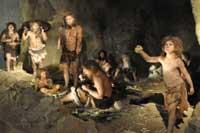Neandertal Achilles Tendon
In fact, the idea that Neanderthals were less corridors than we are not new, but there was no evidence for it. Now, research at the University of Arizona has shown that the slower of us would also make room for the lighter Neanderthal, why and for the difference we have in the tendon.

Some researchers believe that the Achilles tendon may be the key to the disappearance of Neanderthals. (Photo: Johannes Krause/Museum of Kaprina Neanderthals)
When running, the Akiles tendon or snail functions as an energy deposit: like a spring, when hitting the feet it stretches and withdraws to help the foot rise. According to the researchers, the greater the storage capacity of the crin, the better the corridor race.
To confirm this, the anthropologist of the University of Arizona, David Raichl, began to analyze background corridors. Using magnetic resonance imaging, it showed that the length of the Achilles tendon was proportional to the efficiency of the runners. If the tendon is short, it takes a lot of strength to stretch it, so it accumulates a lot of energy. Therefore, the Akiles short tendon runners are more effective, that is, they have an advantage over the long tendon runners.
Later, Raichel investigated the Neanderthal fossils and realized that the bones of his heels were much longer than ours. Conclusion: Conclusion: Conclusion: They had the long tendons of Achilles. That is, they were not so effective running.
According to Raichel, surely the Neanderthals did not have to travel very long paths. They were also skilled at hunting, spying and hunting animals by surprise. However, our ancestors lived in the warm African savannah and to hunt animals they had to travel great distances. Therefore, they had no choice but to be effective running, but they would drown.
Seeking causes of extinction
Other researchers have gone further in their conclusions and have proposed that the key to the disappearance of Neanderthals and our survival is in the area of the Achilles heel. According to them, when the climate cooled and the closed forests became tundra, the ability to hunt and run in large areas was beneficial to our ancestors. This allowed them to impose themselves on the Neanderthals.
Although the hypothesis seems reasonable, experience demonstrates the convenience of taking them prudently. They have had to cancel more than one hypothesis that explained the disappearance of Neanderthals, after finding evidence against the hypothesis. This is what has happened, for example, this same year with the hypothesis of food.
In fact, until recently many scientists believed that food led the Neanderthals to disaster. Of the fossils found in their caves and places of residence, the researchers concluded that the Neanderthals were purely carnivorous. However, recently Neanderthal dental remains have been investigated and they have realized they were wrong: the Neanderthals ate seeds, fruits and plants. If they have found no more vegetable remains in the houses, it is because they are lost more easily than the bones, not because they collected them and did not eat them. In addition, tests have been found that were made to the fire. Therefore, in addition to omnivores, they were also cooks. But the corridor does not seem, for the moment.
Published in Gara
Buletina
Bidali zure helbide elektronikoa eta jaso asteroko buletina zure sarrera-ontzian











